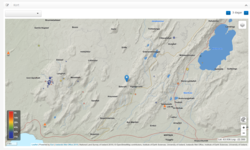M5.6 at the Reykjanes peninsula
The largest earthquake measured since 2003
Updated 27.10.2020
Seismic activity has decreased significantly in recent days. About 180 earthquakes of magnitude 2.2 or less were detected the last two days, for comparison, during the first 24 hours following the 5.6 earthquake in Núpshlíðarháls, about 1700 earthquakes were detected in the area. "It is difficult to say whether the activity is coming to an end or only temporarily reduced", says Einar Hjörleifsson, specialist in natural hazards at the Icelandic Met Office. "Given the number and magnitude of earthquakes in recent days, it is likely that the activity in the area is approaching the normal background activity. As residents of the Reykjanes peninsula know, the seismic activity on the entire peninsula has been rather high this year, and the center of activity has moved between different areas. This activity is a part of an active long-term process in the peninsula, but it is difficult to predict what will happen next," says Einar.
Updated 23.10.2020
Seismic activity on the Reykjanes peninsula has
decreased during the last 24 hours. A magnitude 2.6 earthquake shook the region
at 9 a.m. this morning. The activity has mostly been confined to areas west of
Lake Kleifarvatn, and it is difficult to say whether it is coming to an end.
The seismic activity might well move to the east towards Brennisteinfjöll
Mountains as history indicates.
The ongoing seismic swarm is interpreted as being a part of a sequence of
events that began on the Reykjanes peninsula at the end of 2019 and reaches
from Eldey skerry in the west to Krýsuvík in the east. This activity, which
consists of both seismic activity and magma intrusions, could be long and
periodic. The center of activity can shift between areas on the peninsula.
Along the Reykjanes peninsula and the Reykjanes ridge there are plate
boundaries and the volcanic systems, Eldey, Reykjanes-Svartsengi, and Krýsuvík,
transect these boundaries.
Be aware of the hazards related to seismic activity, such as:
- Landslides and rock falls can occur following large earthquakes, most likely in areas with unstable slopes, steep rock walls and loose material, e.g. in the vicinity of Lake Kleifarvatn.
- Earthquakes of magnitude M5.5-6 can take place on the Reykjanes peninsula. Such earthquakes may cause damage e.g. in the capital area.
- Gas can accumulate at low topographies when there is no or calm wind.
- Icelandic Met Office continues to follow the development closely.
Published 20.10.
At 13:43 today (20th of October) an earthquake of M5.6 occurred in Núpshlíðarháls, about 5 km west of the geothermal area in Seltún on the Reykjanes peninsula. The earthquake was felt widely around the country, especially the southern part of the Reykjanes peninsula and in the capital area, which is some 25 km from the epicenter. At this time over 250 aftershocks have been detected, the largest ones in the period between 15:27 and 15:32. The largest was of M4.1, other earthquakes between 3.0 and 3.8. There are no signs of volcanic unrest in the area.
The earthquake today is the largest earthquake measured in the Reykjanes peninsula since 2003.
“There is an active long-term process ongoing in the area and we can expect that there will be more earthquakes in the coming hours that will be felt all the way to the capital area”, says Kristín Jónsdóttir, Earthquake hazards coordinator at the Icelandic Met Office, in an interview with RÚV today.
A great deal of earthquake activity has been ongoing in the peninsula in 2020. Earthquakes of M5 were recorded in July this year, by Fagradalsfjall, just west of where the epicenter of the M5.6 earthquake today was. Earthquake history of the Reykjanes Peninsula shows that large earthquakes have occurred in the past in connection with large earthquake swarms. Therefore, there is the possibility of large aftershocks occurring in this swarm. Largest earthquakes in the area can possibly reach M5.5-6. Those types of earthquakes can cause damages within the capital area.




